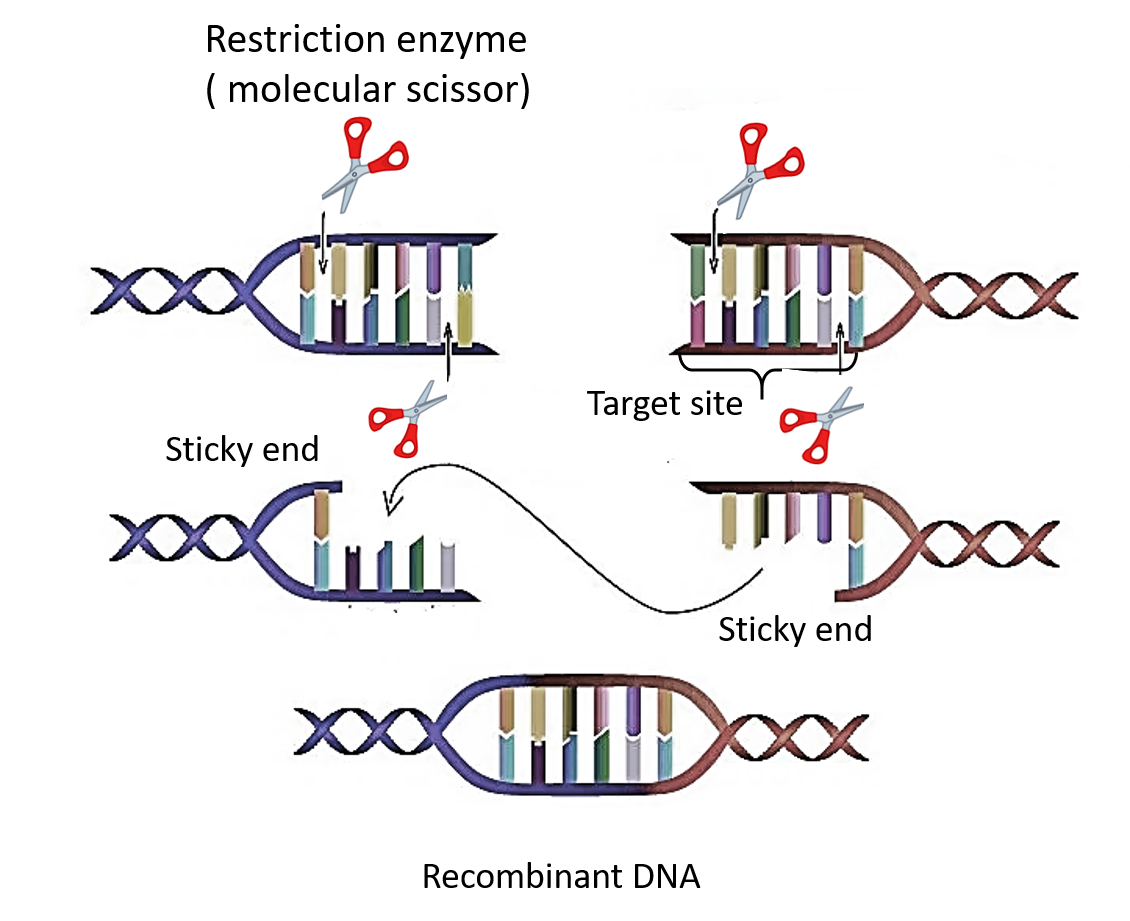
The first restriction endonuclease was
(a) EcoRII
(b) HindII
(c) HindIII
(d) AvaI
Answer
492k+ views
Hint: The first restriction endonuclease was isolated from a Gram-negative pathogenic bacteria which can cause pneumonia or bloodstream infections. The restriction endonuclease is an enzyme commonly known as molecular scissors. It is an important tool in recombinant DNA technology.
Complete answer:
W.Arber was the first scientist who postulated about ‘restriction enzymes.’ He noticed the fragmentation of bacteriophage’s DNA into smaller pieces when bacteriophage injects its DNA into the bacteria. In 1970, Hamilton Smith and his coworkers first isolated a restriction enzyme from the bacterium Haemophilus Influenzae and named it HindII which recognizes a six pair dsDNA sequence.
Additional Information: A restriction endonuclease is an enzyme isolated from bacteria that can cut dsDNA into fragments. It does so by recognizing specific nucleotide sequences as ‘recognition’ or ‘restriction site’. The term ‘restriction’ comes from the observation that these enzymes hamper or obstruct the entry of foreign DNA in the bacteria. EcoRII is isolated from gram-negative Escherichia coli. It recognizes a six pair dsDNA sequence 5’-CCWGG-3’ where W= either Adenine(A) or Thymine(T). It produces sticky ends.
HindIII is isolated from Haemophilus Influenza but discovered later than HindII. Recognition sequence of HindIII is 5’-AAGCTT-3' and it also produces sticky ends. AvaI is a type II restriction enzyme and isolated from Anabaena variabilis.
The naming of restriction endonuclease involves the abbreviations of the bacterial species from which the enzyme is isolated. E.g., Eco- for E. coli and Hin- for H. influenzae. Roman numerals are also used to indicate the sequence of discovery if more than one restriction enzyme has been isolated from the same bacterial strain.

So, the correct answer in ‘HindII.’
Note: The action of restriction enzymes is either blunt or staggered cuts. Blunt ends occur when both ends of cut DNA have a base pair. While in staggered cuts, sticky ends wherein the two cut ends of DNA do not possess any base pair. After the staggering cuts, the resulting restriction DNA fragments possess 5’ overhangs or 3’ overhangs.
Complete answer:
W.Arber was the first scientist who postulated about ‘restriction enzymes.’ He noticed the fragmentation of bacteriophage’s DNA into smaller pieces when bacteriophage injects its DNA into the bacteria. In 1970, Hamilton Smith and his coworkers first isolated a restriction enzyme from the bacterium Haemophilus Influenzae and named it HindII which recognizes a six pair dsDNA sequence.
Additional Information: A restriction endonuclease is an enzyme isolated from bacteria that can cut dsDNA into fragments. It does so by recognizing specific nucleotide sequences as ‘recognition’ or ‘restriction site’. The term ‘restriction’ comes from the observation that these enzymes hamper or obstruct the entry of foreign DNA in the bacteria. EcoRII is isolated from gram-negative Escherichia coli. It recognizes a six pair dsDNA sequence 5’-CCWGG-3’ where W= either Adenine(A) or Thymine(T). It produces sticky ends.
HindIII is isolated from Haemophilus Influenza but discovered later than HindII. Recognition sequence of HindIII is 5’-AAGCTT-3' and it also produces sticky ends. AvaI is a type II restriction enzyme and isolated from Anabaena variabilis.
The naming of restriction endonuclease involves the abbreviations of the bacterial species from which the enzyme is isolated. E.g., Eco- for E. coli and Hin- for H. influenzae. Roman numerals are also used to indicate the sequence of discovery if more than one restriction enzyme has been isolated from the same bacterial strain.

So, the correct answer in ‘HindII.’
Note: The action of restriction enzymes is either blunt or staggered cuts. Blunt ends occur when both ends of cut DNA have a base pair. While in staggered cuts, sticky ends wherein the two cut ends of DNA do not possess any base pair. After the staggering cuts, the resulting restriction DNA fragments possess 5’ overhangs or 3’ overhangs.
Recently Updated Pages
Master Class 12 Economics: Engaging Questions & Answers for Success

Master Class 12 Maths: Engaging Questions & Answers for Success

Master Class 12 Biology: Engaging Questions & Answers for Success

Master Class 12 Physics: Engaging Questions & Answers for Success

Master Class 12 Business Studies: Engaging Questions & Answers for Success

Master Class 12 English: Engaging Questions & Answers for Success

Trending doubts
Draw a labelled sketch of the human eye class 12 physics CBSE

The final image formed by a compound microscope is class 12 physics CBSE

Differentiate between homogeneous and heterogeneous class 12 chemistry CBSE

What are the major means of transport Explain each class 12 social science CBSE

Which of the following properties of a proton can change class 12 physics CBSE

Sum of two skew symmetric matrices is always matri class 12 maths CBSE




